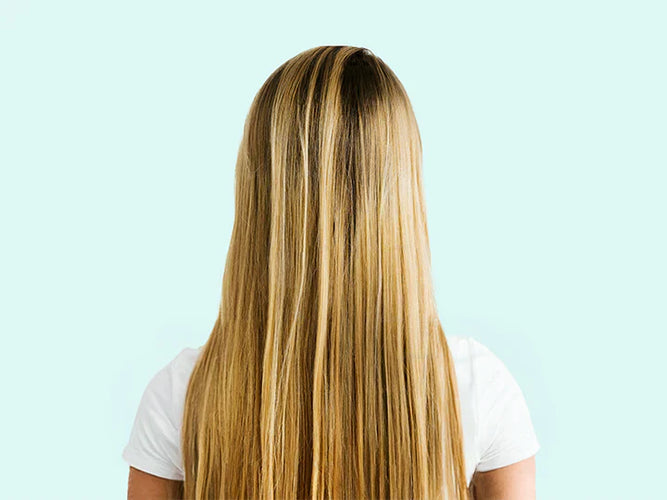Your hair grows, rests and eventually falls out before a new cycle begins. This happens in different phases that together make up the hair growth cycle. The cycle affects how long your hair can grow and how full it looks. In this article, you will learn how the hair growth cycle works, what the different hair growth phases are and how the hair follicle and hair shaft play a role.
The hair growth cycle explained
Your hair grows from the hair follicle, where small blood vessels bring oxygen and nutrients to the hair root. In good conditions, a hair can grow about 0.3 millimetres per day. Human hair grows asynchronously, which means that each hair is in a different phase of the hair growth cycle at any given time. There can be seasonal changes, but these vary from person to person.
The hair growth cycle has three main stages:
- Anagen phase (growth)
- Catagen phase (transition)
- Telogen phase (rest)

Infographic: 3 stages of the hair growth cycle
Sometimes a fourth stage is mentioned: the exogen phase. This is actually part of the telogen phase and refers to the moment when the hair sheds and makes room for new growth. Because this stage overlaps strongly with telogen, we do not treat it as a separate phase in our explanation.
The three stages of the hair growth cycle
Anagen phase (growth)
The anagen phase is the active growth stage of the hair. During this period, the cells in the hair root divide continuously, which allows the hair to grow about 1 centimetre per month. For most people, this stage lasts between 2 and 6 years, but in some cases it can continue for 7 years or even longer. The longer the anagen phase lasts, the longer the hair can grow.
The main difference between scalp hair and other body hair is the length of this growth stage. Eyebrows and eyelashes have a much shorter anagen phase of around 30 to 45 days, which is why they never grow as long as the hair on your head.
Catagen phase (transition)
The catagen phase is the short transition stage between growth and rest. During this period, the hair stops growing and the hair follicle begins to shrink. The hair root also separates from its blood supply, preparing the hair for the resting stage that follows. This phase lasts about 2 to 3 weeks, and only 1 to 3% of all hairs are in this transition stage at any given time.
Telogen phase (rest)
The telogen phase is the resting stage of the hair growth cycle and usually lasts 2 to 4 months. During this period, the follicle does not produce new hair. The existing hair, also called a club hair, stays in the follicle for a while. At the end of this phase, the hair loosens and falls out, after which the follicle can begin a new growth stage. This natural shedding explains why a healthy person loses about 50 to 100 hairs per day. If the amount of shedding is consistently higher than this, it can lead to visibly thinner hair.
What can disrupt the hair growth cycle?
Several factors can disturb the hair growth cycle, causing your hair to shed faster or grow less well. Common causes include:
- Genetic factors, such as androgenetic alopecia
- Hormonal changes, for example during pregnancy, thyroid problems or menopause
- Reduced blood flow to the scalp, which can affect the condition of the follicles
- Vitamin and mineral deficiencies, such as low iron, vitamin D or biotin
- Long-term stress, which can lead to telogen effluvium
- Natural ageing, which can shorten the anagen phase
- Use of certain medications, including chemotherapy, antidepressants or blood thinners
- Autoimmune conditions, such as alopecia areata
Would you like to learn more? Read our article about the causes of hair loss.
What can you do to keep your hair in the growth phase for longer?
Depending on your situation, you can choose a routine that supports the condition of your hair and scalp. The goal is to help your hair look stronger, fuller and healthier.
-
Routine for thinning-looking hair: A combination of a shampoo and a nutritional supplement can support the hair and scalp and help your hair look stronger and fuller.
-
Routine advanced hair loss treatment: For extra support, you can use a more complete routine with tablets, shampoo, conditioner and lotion.
- Additional tools: A scalp roller can be added to your routine to support the absorption of caring products into the scalp. Only use it as instructed to avoid scalp irritation.
Curious what else you can do besides using stimulating hair growth routines? Read more in our blog about stimulating hair growth.
FAQ
How much does hair grow per month?
On average, hair grows about 1 centimetre per month, but this can vary from person to person. Factors such as age, lifestyle and genetics all play a role. Read more details in our article: how fast does hair growth.
Is it normal to lose hair?
Yes, it is normal to lose 50 to 100 hairs per day. This is part of the natural hair growth cycle.
Can you speed up hair growth?
You cannot change the cycle itself, but good care for your scalp and hair can help it look healthier and stronger.
Conclusion
Your hair grows in a fixed cycle with three main stages: the anagen (growth), catagen (transition) and telogen (rest) phase. How these stages run determines how long, full and healthy your hair can become. Different factors can disturb this cycle and cause hair to shed faster or grow back thinner.
Sources
Stenn, K. S., & Paus, R. (2001). Controls of hair follicle cycling. Physiological Reviews, 81(1), 449–494. https://journals.physiology.org/doi/full/10.1152/physrev.2001.81.1.449
Sinclair, R. D., & Dawber, R. P. R. (2001). Hair loss in women: medical and cosmetic approaches to increase scalp hair fullness. British Journal of Dermatology, 145(5), 849–853. https://academic.oup.com/bjd/article-abstract/
American Academy of Dermatology (AAD). (z.d.). Hair loss: Overview. https://www.aad.org/public/diseases/hair-loss/insider
Mayo Clinic. (z.d.). Hair loss (alopecia): Symptoms and causes.
Trüeb, R. M. (2009). Oxidative stress in ageing of hair. International Journal of Trichology, 1(1), 6–14. https://journals.lww.com/IJOT/pages/default.aspx
This information does not replace professional medical advice. If in doubt, always consult a doctor or specialist.













